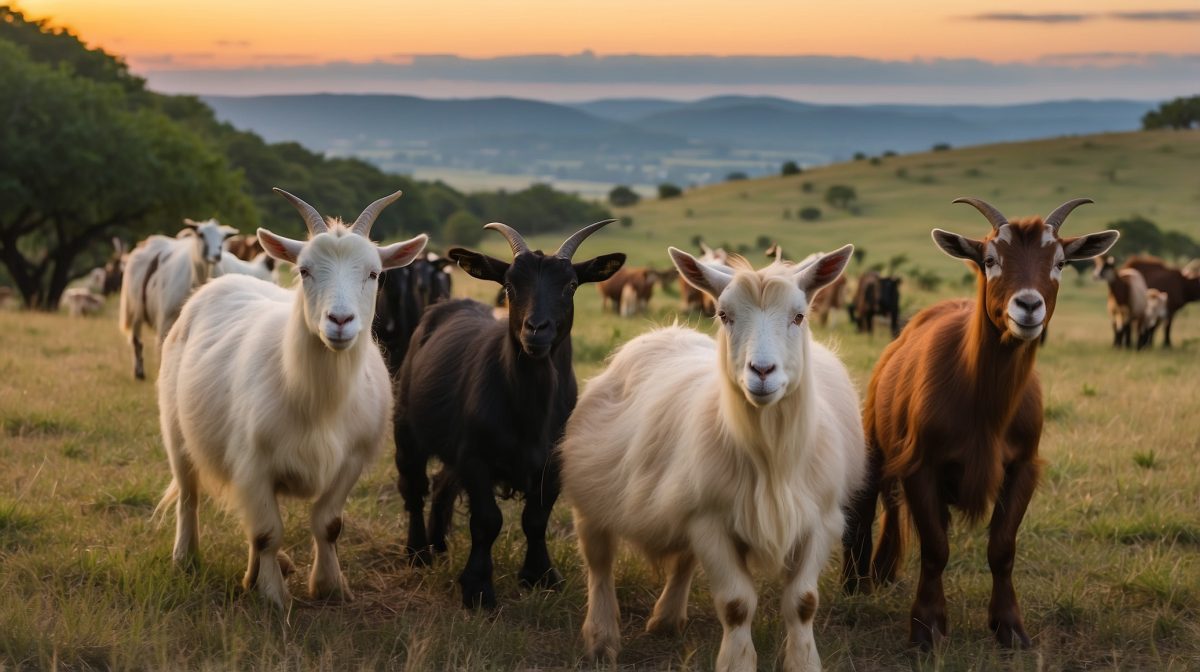Now, I know y’all might be thinkin’ about gettin’ your own herd started, and I’m here to help you figure out just how to do that without overburdenin’ your land. It’s all about findin’ that sweet spot where your goats are happy, your land’s well-managed, and you’re gettin’ the most out of this wonderful lifestyle. So, let’s get to it and explore the ins and outs of goat density in Texas Hill Country.
Understanding Texas Hill Country Terrain
Before we get to numbers, it’s important to understand the lay of the land here in Hill Country. We’re talkin’ about a region with diverse terrain, from lush grasslands to rocky outcrops, and each little piece of land’s got its own personality. This variety ain’t just for show; it matters a heap to your goats. They’ll need the right kind of forage and shelter to thrive, and that’s somethin’ you’ve got to consider when calculatin’ how many goats per acre you can sustain.
Y’all also need to know that the vegetation here is as varied as the terrain. We’ve got native grasses, shrubs, and trees that are not just easy on the eyes but are also mighty tasty to your herd. Goats are natural browsers, and they’ll make the most of what Hill Country’s got to offer, but you’ve got to be mindful of the balance between their grazin’ habits and the land’s ability to recover. That’s the key to keepin’ both the land and your goats in tip-top shape.
Benefits of Raising Goats in Texas Hill Country
Goats ain’t just cute – they’re practical! Raisin’ these critters in Texas Hill Country comes with a heap of benefits. For starters, they’re exceptional at land management. A well-managed herd can clear out underbrush, reduce fire hazards, and improve the quality of the pasture for other livestock. Plus, they’re easier on the land than some bigger animals, which means less erosion and better soil health over time.
Then there’s the economic value. Goats can be a source of various products, from that delicious cheese I mentioned earlier to meat and even fiber. They’re versatile animals, and with the right approach, they can add a solid stream of income to your ranchin’ operations. Not to mention, they’re just plain enjoyable to have around, and that’s somethin’ you can’t put a price on.
Factors Affecting Goat Density
Now, you can’t just plop down any number of goats on your land and expect things to go smoothly. There’s a few factors you need to consider to figure out the right number of goats per acre. Forage availability is at the top of the list – you’ve got to make sure there’s enough to eat without strippin’ the land bare. Different plants and grasses have different nutritional values, and your goats need a balanced diet to stay healthy.
We also need to talk about land management practices. Overgrazin’ can lead to soil erosion and poor pasture health, so it’s important to rotate your herds and give the land time to recover. And don’t forget about goat breeds – some are heartier and need less, while others might require a bit more pamperin’. All these factors will influence how many goats your land can support, and we’ll need to weigh them carefully.
Recommended Goat Density
Based on the factors we’ve discussed, I’m fixin’ to give y’all a recommended range for goat density in Texas Hill Country. Now, this ain’t a one-size-fits-all situation, but generally speakin’, you’re lookin’ at between 6 to 8 goats per acre as a starting point. This should give your goats plenty of space to roam and graze without puttin’ too much pressure on the land.
Keep in mind, this is just a guideline. You’ll need to adjust based on your specific situation, takin’ into account the quality of forage, the breed of your goats, and how well you manage your pasture. It’s all about findin’ that balance, and with a little observation and adjustment, you’ll get there.
Managing Your Goats Responsibly
With great goats comes great responsibility. It’s crucial to manage your herd in a way that keeps your land and goats healthy and productive. This means regular health check-ups, proper nutrition, and a keen eye on the pasture. If you notice the land startin’ to look a bit worn, it might be time to move the herd to a new area or reduce the number of goats you’re keepin’.
It’s also about being a good neighbor and steward of the land. Implementin’ practices like rotational grazing can make a big difference in the health of your pasture and, ultimately, the health of your goats. And remember, happy goats make for happy goat keepers, so it’s worth the effort to do things right.
Conclusion
We’ve covered quite a bit of ground here, folks. Balancin’ the needs of your land with the joy of raisin’ goats in Texas Hill Country is a rewarding challenge. Remember, every piece of land and every herd is unique, so while the guidelines we’ve discussed are a good startin’ point, the real magic happens when you tune in to what your specific situation calls for.
Keep your eyes peeled, your mind open, and your heart set on the wellbeing of your goats and your land, and you’ll find that sweet spot of goat density that’s just right for you. Happy ranchin’, y’all!
FAQs
What breeds of goats are best suited for Texas Hill Country?
Spanish, Boer, and Myotonic (Fainting) goats are well-suited for Texas Hill Country due to their hardiness and adaptability to the terrain.
How does the terrain in Texas Hill County affect goat grazing habits?
The varied terrain leads goats to browse more than graze, which helps prevent overgrazing and promotes land health.
Can you raise meat goats and dairy goats together on the same land?
Yes, meat and dairy goats can coexist on the same land, but their nutritional needs and management may differ.
What are the signs that I might have too many goats on my acreage?
Signs include overgrazed pastures, soil erosion, and poor herd health, indicating the land’s carrying capacity has been exceeded.
How do seasonal changes in Texas Hill Country impact goat farming?
Seasonal changes affect forage availability and quality, requiring adjustments in herd size and management practices to maintain balance.


